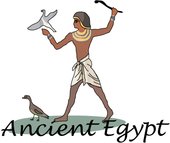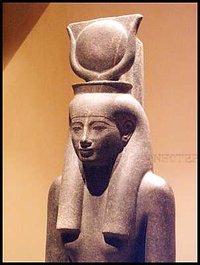Hathor
|
|
| Contents |
Mother of Horus
In Egyptian mythology, Hathor (Egyptian for house of Horus) was originally a personification of the milky way, which was seen as the milk of a heavenly cow. Her name refers to her position as the celestial cow which encircled the sky and consequently the god of the sky, Horus, in his original form. Hathor was originally seen as the daughter of Ra, the creator, whose own cosmic birth was formalised as the Ogdoad cosmogeny. Hathor was an ancient goddess, worshipped as a cow-deity from at least 2700 BC, during the 2nd dynasty, and possibly even by the Scorpion King.
As a provider of milk, and due to cows careful tending of their calves, the cow was a universal symbol of motherhood, and so Hathor became goddess of motherhood, gaining titles such as The Great Cow Who Protects Her Child and Mistress of the Sanctuary of Women. Because of the aspect of motherhood, her priests were oracles, predicting the fate of the newborn, and midwives delivering them.
As a mother, since she enclosed the sky, she was seen as the mother of Horus. Symbolically she became the divine mother of the pharoah, who was identified as Horus. Since Horus' wife was Isis, Hathor was sometimes said to be her mother, although it was more accurate to say she was her mother in law. As Horus was also said to be the son of Ra, Hathor was identified as Ra's wife (Ra created her in a non-sexual manner), gaining the title Mistress of Heaven. Having been identified as Ra's wife, it was said she arose from from Ra's tears, and thus was identified as the Eye of Ra.
In art, Hathor was often depicted as a golden cow (sometimes covered in stars), with the titles Cow of Gold, and The one who shines like gold, or as a woman with the ears of a cow and a headdress of horns holding the sun-disc, which represented Ra. Also, Hathor was sometimes identified as an hippopotamus, which the Egyptians also considered quite motherly creatures, and sometimes as an aquatic form of the cow.
In her position as divine mother to the pharoah, Hathor would sometimes be depicted as a cow standing in a boat (representing the boat of Ra with which he, as the sun, crosses through the sky), surrounded by tall papyrus reeds (as were common in the Nile delta), with the pharaoh often pictured as a calf standing next to her. As divine mother, she was also represented with, or as, an uraeus, a stylised cobra, which symbolised royal power.
Sometimes, the local depictions of Hathor, with their slight variations on emphasising certain features, were treated seperately, and 7 of them, any 7, which was perceived as a mystical number (it divides the lunar month into 4 equal parts, and was the number of known planets at the time), named by their different titles, were considered special if gathered together. These Seven Hathors, in Hathor's context as a mother, were said to dress in disguise as young women, and attend the birth of a child, and then one by one announce aspects of his fate. In later centuries, this, 7-fold, aspect of Hathor, was identified as the Pleiades.
Fertility goddess
The cow's large eyes with long lashes and generally quiet demeanor were often considered to suggest a gentle aspect of feminine beauty. There are still cultures in the world where to say that a girl is as pretty as a heifer is a great compliment, rather than taking you cow as an insult. And so Hathor rapidly became a goddess of beauty, and fertility, thus also a patron goddess for lovers.
A tale grew up around this in which Ra is described as having been upset over Horus' victory over Set (representing the conquest in 3000BC of Lower Egypt by Upper Egypt), and went off to be alone, and so Hathor went to him and started to dance and stripped naked, showing him her genitals, which cheered him up, so he returned. The tale is thought also to describe a solar eclipse, as it depicts Ra, the sun, going away to sulk, and then returning when cheered up.
In her position as a female fertility goddess, who readily strips naked, she was often depicted in red, the colour of passion, and so gained the titles Lady of the scarlet-coloured garment, and Lady of [sexual] offerings (Nebet Hetepet in Egyptian). Sometimes her fertility aspect was depicted symbolically as a field of reeds. Her position as one of beauty lead to her being depicted in portrait, which was highly unusual by Egyptian artistic conventions, indeed, only she and Bes were ever depicted in this manner. Her alleged beauty also lead to her being symbolically depicted by mirrors. Hathor's image was also often used to form the capitals of columns in Egyptian architecture.
Musician
Eventually, Hathor's identity as a cow-goddess of fertility, meant that her Hathor became identified with another ancient cow-goddess of fertility, Bata. It still remains an unanswered question amongst Egyptologists as to why Bata survived as an independant goddess for so long. Bata was, in some respects, connected to the Ba, an aspect of the soul, and so Hathor gained an association with the afterlife. It was said that, with her motherly character, she greeted the souls of the dead in the underworld, and proffered them with refreshments of food, and of drink. She was also somtimes described as mistress of the acropolis.
The assimilation of Bata, who was associated with the sistrum, a musical instrument, brought with it an association with music. In this form, Hathor's cult became centred in Dendera and was led by priests who were also dancers, singers, and other entertainers. Hathor's temple at Dendera contains an extremely controversial image, known as the Dendera Light, which may be a depiction of an electric light. Hathor also became associated with the menat, the turquoise musical necklace often worn by women.
An hymn to Hathor says:
- Thou art the Mistress of Jubilation, the Queen of the Dance, the Mistress of Music, the Queen of the Harp Playing, the Lady of the Choral Dance, the Queen of Wreath Weaving, the Mistress of Inebriety Without End.
Essentially, Hathor had become a goddess of Joy, and so she was deeply loved by the general population, and truly revered by women, who aspired to embody her multifaceted role as wife, mother, and lover. In this capacity, she gained the titles of Lady of the House of Jubilation, and The One Who Fills the Sanctuary with Joy. The worship of Hathor was so popular that more festivals were dedicated to her honour that any other Egyptian deity, and more children were named after this goddess than any other. Even Hathor's priesthood was unusual, in that both men, and women, became her priests.
Bloodthirsty warrior
The Middle Kingdom was founded when Upper Egypt's Pharoah, Mentuhotep II took control over Lower Egypt, which had become independant during the First Intermediate Period by force. This unification had been achieved by a brutal war that was to last some 28 years, but when it ceased, calm returned, and the reign of the next Pharoah, Mentuhotep III, was peaceful, and Egypt once again became prosperous. A tale, from the perspective of Lower Egypt, developed around this.
In the tale, Ra (representing the Pharoah of Upper Egypt), was no longer respected by the people (of Lower Egypt), and they ceased obeying his authority, which made him so angry that he sent Sekhmet (war goddess of Upper Egypt) out to destroy them, but Sekmet was so bloodthirsty that she could not be stopped. Ra pours blood-coloured beer on the ground, tricking Sekhmet, who thinks it to be blood, into drinking it, which makes her stop the slaughter, and become loving, and kind.
The form that Sekhmet had become by the end of the tale was identical in character to Hathor, and so a cult arose, at the start of the Middle Kingdom, which dualistically identified Sekhmet with Hathor, making them one goddess, Hathor-Sekhmet, with two sides. Consequently, Hathor, as Hathor-Sekhmet, was sometimes depicted as a lioness. However, the two goddesses were so different, indeed almost diametrically opposed, that the identification did not last.
Later years
When the Ennead and the Ogdoad were combined, when Ra and Atum were identified as one another, Hathor, as the daughter of the combined Atum-Ra, was sometimes confused with Tefnut. Consequently, the tale, a metaphor for an historic drought, in which Tefnut had fled egypt after an argument with her husband (Shu), but is persuaded to return, became occasionally transformed into one in which Hathor had an argument with Ra, and fled, later returning. The aspect of the story in which Tefnut turned into a cat and attacked those who went near, neatly fitted with the tale in which Hathor was said to have been Sekhmet, contributing to the frequency with which the tale occured featuring Hathor rather than Tefnut.
Beliefs about Ra himself had been hovering around the identification of him, a sun god, with Horus, who by this time was also a sun god, in the combined form Ra-Herakhty, and so for some time, Isis had intermittently been considered the wife of Ra, since she was the wife of Horus. Consequently, Hathor became identified with Isis, and since this identification was much simpler than that of Horus and Ra, it was more strongly, and more permanantly made.
In this form, which, technically, is really Isis, Hathor's mother was consequently Nuit, and she was sometimes even described as being the wife of Horus, leading to a level of confusion, in which Horus, as Hathor's son, was also his own father. This form of Horus was known as Horus-Bedhety, referring to Bedhet, where the view was most commonly held, or as Ihy, referring to his aspect as a sistrum player, since he was the son of Hathor, who was by now associated with the sistrum. When Horus assimilated with Anhur, to become Arsnuphis, so Hathor was occasionally Anhur's mother as well.
Nethertheless, when Ra subsequently assimilated Amun, into Amun-Ra, it was sometimes said that Hathor, as a cow, was married to Sobek, or rather to a generic crocodile-god, since Sobek had become thought of as merely a manifestation of Amun. Shortly afterwards, Hathor became fully merged into Isis, whose cult was much stronger.
Hathor outside the Nile
Hathor was worshipped in Canaan in the 11th century BC, which at that time was ruled by Egypt, at her holy city of Hazor, which the Old Testament claims was destroyed by Joshua (Joshua 11:13, 21). The Sinai Tablets show that the Hebrew workers in the mines of Sinai about 1500 BC worshipped Hathor, whom they identified with the goddess Astarte. Some theories state that the golden calf mentioned in the bible was meant to be a statue of the goddess Hathor (Exodus 32:4-32:6.), although it is more likely to be a representation of the 2 golden calves set up by Rehoboam, an enemy of the levite priesthood, which marked the borders of his kingdom.
The Greeks also loved Hathor and equated her with their own goddess of love and beauty, Aphrodite.
Other spellings
- Athor
- Het-Hert
- Het-Heru
- Hwt-Hert
See also
Ancient Egypt Clipart and Pictures
- Ancient Egypt Architecture (http://classroomclipart.com/cgi-bin/kids/imageFolio.cgi?direct=History/Ancient_Civilizations/Ancient_Egypt/Architecture)
- Ancient Egypt Art (http://classroomclipart.com/cgi-bin/kids/imageFolio.cgi?direct=History/Ancient_Civilizations/Ancient_Egypt/Art)
- Ancient Egypt Clipart (http://classroomclipart.com/cgi-bin/kids/imageFolio.cgi?direct=History/Ancient_Civilizations/Ancient_Egypt/Clipart)
- Ancient Egypt Clothing (http://classroomclipart.com/cgi-bin/kids/imageFolio.cgi?direct=History/Ancient_Civilizations/Ancient_Egypt/Clothing)
- Ancient Egypt Architecture (http://classroomclipart.com/cgi-bin/kids/imageFolio.cgi?direct=History/Ancient_Civilizations/Ancient_Egypt/Commerce)
- Ancient Egypt Daily Life (http://classroomclipart.com/cgi-bin/kids/imageFolio.cgi?direct=History/Ancient_Civilizations/Ancient_Egypt/Daily_Life)
- Ancient Egypt Games and Toys (http://classroomclipart.com/cgi-bin/kids/imageFolio.cgi?direct=History/Ancient_Civilizations/Ancient_Egypt/Games_and_Toys)
- Ancient Egypt Hieroglyphs (http://classroomclipart.com/cgi-bin/kids/imageFolio.cgi?direct=History/Ancient_Civilizations/Ancient_Egypt/Hieroglyphs)
- Ancient Egypt People (http://classroomclipart.com/cgi-bin/kids/imageFolio.cgi?direct=History/Ancient_Civilizations/Ancient_Egypt/Historical_People)
- Ancient Egypt Illustrations (http://classroomclipart.com/cgi-bin/kids/imageFolio.cgi?direct=History/Ancient_Civilizations/Ancient_Egypt/Illustrations)
- Ancient Egypt Mummies (http://classroomclipart.com/cgi-bin/kids/imageFolio.cgi?direct=History/Ancient_Civilizations/Ancient_Egypt/Mummies)
- Ancient Egypt Musical Instruments (http://classroomclipart.com/cgi-bin/kids/imageFolio.cgi?direct=History/Ancient_Civilizations/Ancient_Egypt/Musical_Instruments)
- Ancient Egypt Pyramids (http://classroomclipart.com/cgi-bin/kids/imageFolio.cgi?direct=History/Ancient_Civilizations/Ancient_Egypt/Pyramids)
- Ancient Egypt Religion (http://classroomclipart.com/cgi-bin/kids/imageFolio.cgi?direct=History/Ancient_Civilizations/Ancient_Egypt/Religion)
- Ancient Egypt Statues (http://classroomclipart.com/cgi-bin/kids/imageFolio.cgi?direct=History/Ancient_Civilizations/Ancient_Egypt/Statues)
- Ancient Egypt Temples (http://classroomclipart.com/cgi-bin/kids/imageFolio.cgi?direct=History/Ancient_Civilizations/Ancient_Egypt/Temples)
- Ancient Egypt Transportation (http://classroomclipart.com/cgi-bin/kids/imageFolio.cgi?direct=History/Ancient_Civilizations/Ancient_Egypt/Transportation)
- Ancient War and Armies (http://classroomclipart.com/cgi-bin/kids/imageFolio.cgi?direct=History/Ancient_Civilizations/Ancient_Egypt/War_and_Armies)


